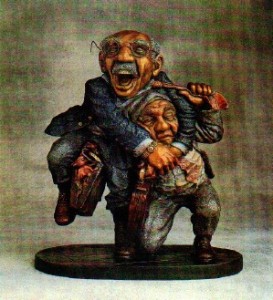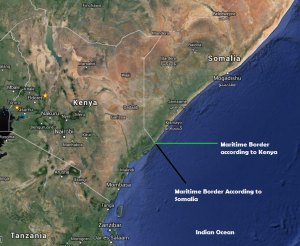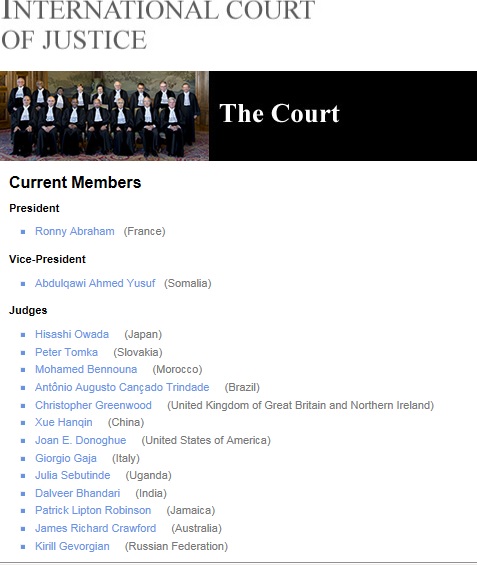By Ahmed Hirsi
The dispute concerning the delimitation of maritime boundary between Kenya and Somalia in the Indian Ocean has been building up for quite some time and neither side is willing to back down, given the significance of the case which is hinged on various variables such as national pride, sovereignty not to mention the existing vast amount of oil, fish and minerals in the disputed area.

At regular interval each government profoundly professes that it’s going to triumph, albeit Kenya has continuously echoed that it prefers an out of court settlement in which many Somalis contemplate as premeditated diplomatic trap, since Kenya recognized from the outset that it was dealing with a shaky case with provenance of a skeleton argument with very little or no weight at all.
Kenya has an entirely unique narrative as to why it is seeking an out of court settlement. Most legal experts assert that Kenya’s predilection for an out of court settlement is an abnormally complicated diplomatic manoeuvre stemming from the United Nations Law on Sea- UNCLOS which requires countries to submit or to enter into MoU – Memorandum of Understanding with neighboring states on the limits of their maritime boundaries before cases are presented to ICJ- International Court of Justice for arbitration.
On its part Kenya diligently went beyond and above to ‘beat’ the deadline which was set to be in 2009 and it virtually achieved that by signing a memorandum of understanding in 2009 with the Somali Interim Government headed by Sheikh Sharif that denoted the border would run east along the line of latitude. At the time of signing the MoU-Somalia had no effective central government capable of administering such sophisticated task.
Hence, a big segment of Somalis still share the notion that the MoU was ingeniously designed by Kenya and Norway to annex a big chunk of Somalia’s territorial water.
When confronted those who subscribe or believe into this conspiracy theory would argue that the sheer speed and the manner in which the MoU was signed at the early stages of Sheikh Sharif’s tenure as interim president is symptomatic of a pre-planned Kenyan hidden agenda.
Another theory that has been in circulation is that the main reason behind Kenya giving Sheikh Sharif safe haven in Kenya after the Union of Islamic Courts was driven out of Somalia by Ethiopian incursion on behalf of United States of America, was aimed at forging fake friendship and Kenya was truly setting up a trap to con Sheikh Sharif and Somalia out of the ‘disputed’ sea-territory.
Out of this risky and alarming situation which physically hit a raw nerve relating to Somalia’s sovereignty and territorial integrity, triggered massive public uproar predominantly in the diaspora coercing the current Somali Federal Parliament to unanimously reject and nullify the MoU, thus rendering it null and void, on the grounds that the signatory party was an interim government not mandated to carry out such imperious venture and the minister who signed the deal lacked both diplomatic merit as well as bureaucratic background to executive the MoU on behalf of Somalia.
The maritime- boundary dispute
 The dispute itself revolves around Somalia’s view which is; the maritime border should continue along the line of the land border, to the southeast diagonally and says a horizontal border would be unfair. Kenya, however, wants the sea border to go in a straight line east, giving it more sea territory and all the oil and gas that is said to be in that triangle. According to Olivier Ribbelink an International law expert at the TMC Asser Institute argues ‘this dispute is all about what really lies in the continental shelf in Somalia’s application. That is where all the ‘potential goodies’ can be found’.
The dispute itself revolves around Somalia’s view which is; the maritime border should continue along the line of the land border, to the southeast diagonally and says a horizontal border would be unfair. Kenya, however, wants the sea border to go in a straight line east, giving it more sea territory and all the oil and gas that is said to be in that triangle. According to Olivier Ribbelink an International law expert at the TMC Asser Institute argues ‘this dispute is all about what really lies in the continental shelf in Somalia’s application. That is where all the ‘potential goodies’ can be found’.
It’s additionally worth mentioning to point out that Somalia’s interpretation of the MoU itself varies from Kenya’s perception of the MoU it entered with Sheikh Sharif’s Interim Government. Somalia asserted the MoU it signed was a document that paved the way for each county to submit to UNCLOS what it perceives to be its maritime border, I think something must have been lost in translation, in other words Somalia claimed both countries agreed to disagree.
Kenya’s strength and weaknesses
Persuasion
As one lawyer put it in a law book, there are two critical elements in the successful exhibition of any case in court. ‘The first has to do with the substance of the argument and the claim; does the evidence support the argument and is the claimant entitled to what he is seeking? These are the nuts and bolts of any case. And the second element – persuasion – is at least as important as the first’.
In light of this let’s now break down the persuasions Kenya might present to the court and use against Somalia. A more proximate scrutiny of what we already know or the ‘known knowns’ relevant for the analysis and the greater understanding of this complex case is needed. So far Kenya has kept its card close on its chest and no-one knows for sure what it might bring to the table.
Here are some of the arguments Kenya is definitely going to employ and use to its advantage.
A number of high ranking Kenyan government officials have so far used these arguments before in the Kenyan media albeit, I could not find any logic or find any correlations between these issues and the maritime dispute itself.
The over half a million Somali refugees sheltered in Kenya
Quite frankly, Kenya hosted Somali refugees for over 20 years on its soil. It’s incontrovertibly true that Kenya sponsored, hosted and backed the formation of several interterm Somali governments on its soil together with dozens of reconciliation conferences for which Somalis should interminably be thankful to Kenya.
There are additionally those who argue that Kenya has profoundly benefited from the disintegration of the Somali state. For instance Kenya exports Miraa/ Khat worth millions of dollars on daily basis to Somalia. According to the latest UN Monitoring Group Report- the Khat tax tariff collected by the Somali government is in the region of one million US Dollars a month.
The quantification or evaluation of taxes paid by Khat distributers is demonstrative of the true nature and utter scale and degree of Khat Kenya exports to Somalia. A number of other manufactured goods emanating from Kenya end up in Somalia as well, however Somalia basically exports for all intents and purposes nothing at all to Kenya.
From economical perspective the trade disparity between these two neighbouring countries doesn’t require magnified glasses for an outsider to observe the conspicuous trade imbalance that does exist between Kenya and Somalia.
Remittance and Somali owned businesses
Kenya benefits from millions of dollars in remittance cash flows sent by Somalis in the diaspora to their families in Kenya that trickles down into major Kenyan cities, thus boosting the Kenyan economy and topping its hard currency reserves . Somalis in the diaspora and refugees alike have set up businesses in Kenya worth millions of dollars and are said to be paying millions in taxes and employing thousands of Kenyans.
Kenyan universities have teamed up with universities in Somalia. Somali civil servants frequently attend various seminars and trainings in Kenya. Hundreds of Somalis are schooled and work in Kenya. The link and dependency between these two neighbouring countries are many and this is indicative of the interdependence between the two nations.
Kenya Defence Forces- KDF- presence in Jubaland a big burden for Kenya
Kenya suffered a number of serious terror attacks in Nairobi, Garissa and Mombasa and lost hundreds if not thousands of its citizen into terror attacks planned and directed from Somalia and this could be used to defend KDF presence in Jubaland. However, there are those who argue that Kenya’s biggest motive and presence in the disputed area is all about the protection of the disputed sea- territory. From legal point of view KDF presence in Somalia regardless of any motives is questionable.
Scholars such as Alex De Waal whom I interviewed recently go as far as claiming that: ‘under UN rules, a country should not normally dispatch troops on a peacekeeping mission into a neighbouring country, and neither should peacekeeping troops be mandated to conduct offensive military operations. AMISOM does not follow these rules’
Norwegian interests and involvement
Norway previously played a key role as mediator in the dispute between the two countries, but although Norway on paper appears to be completely neutral country but the vast amount of oil and gas at stake in the disputed area sadly forced Norway to deviate from its world renowned neutrality.
 Norway being extremely active and dynamic in assisting poor and developing countries, even oil producing nation itself Norwegian legal advisors worked hard to create some sort of temporary fait acompli and as a result of that the maritime dispute brought about allegations by different experts and articles written by different Nordic newspapers claiming that Norway would snatch oil rights in the disputed territory. Deviating from its widely acclaimed non-partisanship, thus denting its reputation on the world stage is not only unwarranted but embarrassing indeed for Norway. Kenya has powerful allies such as USA, Norway and the vast majority of European Union countries. On the diplomatic front Kenya has gathered top lawyers and maritime experts from dozens of countries. On the diplomatic front Kenya has seasoned diplomats who are working around the clock to persuade the court to rule on its favour.
Norway being extremely active and dynamic in assisting poor and developing countries, even oil producing nation itself Norwegian legal advisors worked hard to create some sort of temporary fait acompli and as a result of that the maritime dispute brought about allegations by different experts and articles written by different Nordic newspapers claiming that Norway would snatch oil rights in the disputed territory. Deviating from its widely acclaimed non-partisanship, thus denting its reputation on the world stage is not only unwarranted but embarrassing indeed for Norway. Kenya has powerful allies such as USA, Norway and the vast majority of European Union countries. On the diplomatic front Kenya has gathered top lawyers and maritime experts from dozens of countries. On the diplomatic front Kenya has seasoned diplomats who are working around the clock to persuade the court to rule on its favour.
Somalia’s Weaknesses and Strength
Somalia is recovering from a crippling decade’s long civil war. Despite this the Somali government is confident that it’s going to win this case with ease. The court itself is free for all UN member states. Moreover, both Somalia and Kenya explicitly and voluntarily decided to join, signed and agreed the court’s jurisdiction in the 60ties.both back in the 1960s, both countries individually and explicitly agreed to accept the ICJ’s jurisdiction.
Somalia has already a judge sitting at the court, although he is not allowed to sit and represent Somalia on the 15 members panel of judges, its however huge boast for Somalia. There was a recent case between Peru and Chile on their maritime border, which could shed some light as to who is going to win the case. According to a number of maritime experts Somalia is unlikely to have taken the case to Hague, unless they were pretty sure to have a chance to win. Maybe that is why Kenya is keen on out of court of settlement.
Conclusion
Regardless of the court’s outcome, Kenya and Somalia have a lot in common. There is no reason that, they should go into meaningless war which is reverse development. It’s equally important that we must refuse forces that may trigger animosity, and those who are trying to plant the seed of hatred, Kenya needs Somalis both Kenyan Somalis and Somalia, Somalis and Somalis need Kenya. The winner takes it all. So let’s patiently wait for the court’s decision which may take months if not many years. Perhaps the legal cream could prevent the itch.
Ahmed Hirsi
Email: [email protected]
We welcome the submission of all articles for possible publication on WardheerNews.com. WardheerNews will only consider articles sent exclusively. Please email your article today . Opinions expressed in this article are those of the author and do not necessarily reflect the views of WardheerNews.
WardheerNew’s tolerance platform is engaging with diversity of opinion, political ideology and self-expression. Tolerance is a necessary ingredient for creativity and civility.Tolerance fuels tenacity and audacity.
WardheerNews waxay tixgelin gaara siinaysaa maqaaladaha sida gaarka ah loogu soo diro ee aan lagu daabicin goobo kale. Maqaalkani wuxuu ka turjumayaa aragtida Qoraaga loomana fasiran karo tan WardheerNews.
Copyright © 2024 WardheerNews, All rights reserved


